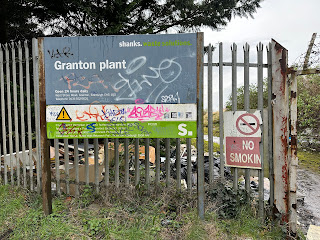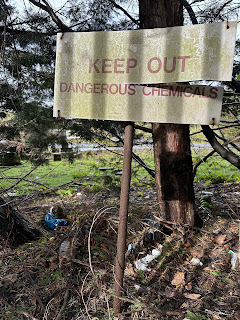When
most people think of land reclaimed from the sea, they think of the Netherlands. There is, however, a little piece of
reclaimed land stretching from Seafield to Leith Docks in Edinburgh. Running
alongside between this land and the sea is Marine Esplanade, a road whose name makes me think of
beachfront bungalows and houses with gardens stretching down to golden sands. A place of ice cream and sandcastles, of fish
and chips by the seaside with hungry seagulls squawking as they circle in
graceful loops above. Sadly, Marine Esplanade holds none of these delights. It is a road that takes you past a sewage
works, some crumbling warehouses and a piece of wasteland that was once a goods
yard where numerous trains would arrive and leave with goods to and from the
docks.
Marine
Esplanade is a road I have walked many times to explore the wasteland, now often
used as an illegal dump, and the abandoned pre-fabs that once housed a couple
of now defunct businesses. In the past
as I walked the road, it was dominated by the distant scenery of huge buildings
in the docks, including the iconic Grain Silo.
This, like many other industrial buildings in and around the docks, has been
demolished in the last few years leaving a view of clear, blue skies where they
once stood. The whole area along by the
Esplanade is changing, buildings left to rot and be destroyed by vandals are now
being cleared and fences are springing up where once you could roam, though
probably weren’t meant to. I assume all
the changes are do with Leith Docks becoming part of the Forth Freeport and re-inventing
itself as a renewable energy hub.
Up
until a couple of years ago you could get into one of the last remaining parts
of Leith Sands from Marine Esplanade. A
scrappy piece of beach that has now unfortunately been fenced off and is inaccessible. I used to go beachcombing there, as it was a
great place to find lots of plastic toys and things. Weathered by the sea and sands, they took on
the glow of objects from antiquity. I
had at first assumed they were washed up due to a kindly sea current depositing
them there, then I realised that they probably all came from the sewage
works. A realisation brought on by one
day finding almost a dozen weathered and worn sets of false teeth scattered
around the beach, making me think that they had most likely arrived there after
being accidentally flushed down the toilet rather than being lost at sea. From this little bit of beach, you could also
access a path that took you round the outside perimeter of the docks to a small
lighthouse. I wandered around that way a
couple of times through a desolate area of rubble and sea on one side, and
crumbling dock buildings and decaying vehicles and machinery on the other. It was hard to imagine as I walked around
there that in the Eighteenth Century the beach at Leith Sands was used for what
was regarded as the most important horse racing event in Scotland, the Leith
Races. The beach used to run for miles,
but was gradually swallowed up by the docks and land reclamation until only a
couple of tiny bits of it were left.
Often,
when wandering around Marine Esplanade, I end up in the wasteland area that was
once a goods yard, or Seafield Goods and Mineral Yard, to give it its full
name. Old maps, such as this one available
from the National library of Scotland –
show
this area as being lined with numerous railway lines on which goods trains were
loaded and unloaded. My mother-in-law,
who spent her childhood in Leith, remembers in the late 1940s sneaking with her
friends into the goods yards of an evening to play, and nose around the stuff
that was stored there. One of the
exciting discoveries they made was a cargo of winter feed for cows, which she
remembered as being a black substance of some type of hardened molasses with a
slight taste of aniseed. Being kids,
they would pull off parts of this to eat, as it was nice and sweet.
For many years there were a load of rusting goods wagons sitting on some
tracks in the yard. They were eventually
towed away by a big diesel train and apart from one fenced off area, the goods
yard is now empty of rail tracks. The once
flat land is now ridged with earth embankments and scattered with rubbish from
illegal dumping. It is an area of burnt
out cars, discarded white goods and remnants of torn out bathrooms and
kitchens. What, may you wonder, is the attraction of
this place then? Well, it is a peaceful
area to walk around, a habitat of wildflowers, numerous butterflies, and
beetles, and lots of crows. It also has
that added extra of being a place where one shouldn’t really be, and sometimes I get a little frisson of excitement from that.
While
out on my most recent trip wandering through the wasteland of the old goods
yard, I left a Skulferatu in one of the earth embankments there.
The coordinates
for the location of the Skulferatu are -
I used the
following sources for information on the former Seafield Goods and Mineral Yard
–













































